Related Research Articles
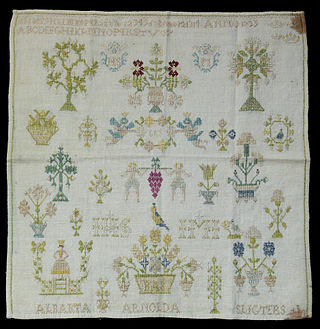
Cross-stitch is a form of sewing and a popular form of counted-thread embroidery in which X-shaped stitches in a tiled, raster-like pattern are used to form a picture. The stitcher counts the threads on a piece of evenweave fabric in each direction so that the stitches are of uniform size and appearance. This form of cross-stitch is also called counted cross-stitch in order to distinguish it from other forms of cross-stitch. Sometimes cross-stitch is done on designs printed on the fabric ; the stitcher simply stitches over the printed pattern. Cross-stitch is often executed on easily countable fabric called aida cloth, whose weave creates a plainly visible grid of squares with holes for the needle at each corner.

Niʻihau, anglicized as Niihau, is the westernmost main and seventh largest inhabited island in Hawaii. It is 17.5 miles (28.2 km) southwest of Kauaʻi across the Kaulakahi Channel. Its area is 69.5 square miles (180 km2). Several intermittent playa lakes provide wetland habitats for the Hawaiian coot, the Hawaiian stilt, and the Hawaiian duck. The island is designated as critical habitat for Brighamia insignis, an endemic and endangered species of Hawaiian lobelioid. The United States Census Bureau defines Niʻihau and the neighboring island and State Seabird Sanctuary of Lehua as Census Tract 410 of Kauai County, Hawaii. Its 2000 census population was 160, most of whom are native Hawaiians; its 2010 census population was 170. At the 2020 census, the population had fallen to 84.

"Do it yourself" ("DIY") is the method of building, modifying, or repairing things by oneself without the direct aid of professionals or certified experts. Academic research has described DIY as behaviors where "individuals use raw and semi-raw materials and parts to produce, transform, or reconstruct material possessions, including those drawn from the natural environment ". DIY behavior can be triggered by various motivations previously categorized as marketplace motivations, and identity enhancement.
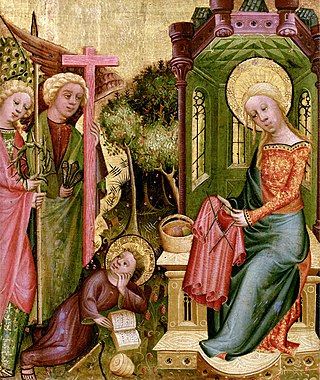
Knitting is the process of using two or more needles to pull and loop yarn into a series of interconnected loops in order to create a finished garment or some other type of fabric. The word is derived from knot, thought to originate from the Dutch verb knutten, which is similar to the Old English cnyttan, "to knot". Its origins lie in the basic human need for clothing for protection against the elements. More recently, hand knitting has become less a necessary skill and more of a hobby.
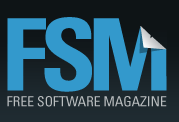
Free Software Magazine is a Web site that produces a mostly free-content online magazine about free software.
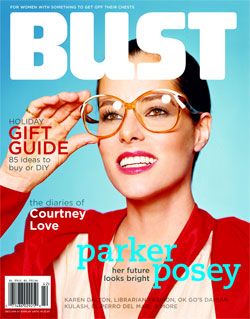
Bust is a women's lifestyle magazine that is published four times a year. The magazine was started by Debbie Stoller and Laurie Henzel and is currently published by Street Media LLC. Bust covers music, news, crafts, art, sex, and fashion from an independent ("indie"), third wave feminist perspective. The magazine's slogan is "For women with something to get off their chest."

Craftivism is a form of activism, typically incorporating elements of anti-capitalism, environmentalism, solidarity, or third-wave feminism, that is centered on practices of craft - or what has traditionally been referred to as "domestic arts". Craftivism includes, but is not limited to, various forms of needlework including yarn-bombing or cross-stitch. Craftivism is a social process of collective empowerment, action, expression and negotiation. In craftivism, engaging in the social and critical discourse around the work is central to its production and dissemination. Practitioners are known as craftivists. The word 'craftivism' is a portmanteau of the words craft and activism.
Make is an American magazine published since June 2019 by Make: Community LLC which focuses on Do It Yourself (DIY) and/or Do It With Others (DIWO) projects involving computers, electronics, metalworking, robotics, woodworking and other disciplines. The magazine is marketed to people who enjoyed making things and features complex projects which can often be completed with cheap materials, including household items. Make is considered "a central organ of the maker movement".

Etsy, Inc. is an American e-commerce company focused on handmade or vintage items and craft supplies. These items fall under a wide range of categories, including jewelry, bags, clothing, home décor and furniture, toys, art, as well as craft supplies and tools. Items described as vintage must be at least 20 years old. The site follows in the tradition of open craft fairs, giving sellers personal storefronts where they list their goods for a fee of US$0.20 per item. Beginning in 2013, Etsy allowed sellers to sell mass-manufactured items.
ReadyMade was a California, United States, bimonthly magazine which focused on do-it-yourself (DIY) projects involving interior design, making furniture, home improvement, sewing, metalworking, woodworking and other disciplines. It also focused on sustainable design, independent music and DIY culture. The magazine was marketed to people who enjoy creating unique items to have at home and wear and featured projects which could often be completed with everyday materials, such as household items.

Loud and Quiet is a British bi-monthly music magazine that focuses on new music from underground indie, alternative, electronic and hip hop artists.

Ravelry is a free social networking service and website that beta-launched in May 2007. It functions as an organizational tool for a variety of fiber arts, including knitting, crocheting, spinning and weaving. Members share projects, ideas, and their collection of yarn, fiber and tools via various components of the site.
Skull-A-Day is an ongoing online art project/blog created by artist Noah Scalin. For its first year the site consisted of daily skull art creations made by Noah as well as weekly submissions by fans of the project. After Noah finished his project, he has continued to post daily images of skulls created by fans to the site.
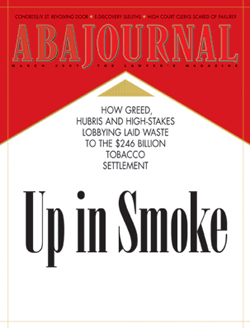
The ABA Journal is a monthly legal trade magazine and the flagship publication of the American Bar Association. It is now complemented online by a full-featured website, abajournal.com and its various e-newsletters and apps.

The maker culture is a contemporary subculture representing a technology-based extension of DIY culture that intersects with hardware-oriented parts of hacker culture and revels in the creation of new devices as well as tinkering with existing ones. The maker culture in general supports open-source hardware. Typical interests enjoyed by the maker culture include engineering-oriented pursuits such as electronics, robotics, 3-D printing, and the use of computer numeric control tools, as well as more traditional activities such as metalworking, woodworking, and, mainly, its predecessor, traditional arts and crafts.
The Printed Blog is a print magazine composed entirely of blogs and other aggregated online content that operates out of its offices in Chicago.

Immediate Media Company Limited is a British multinational publishing house that publishes a significant range of titles, including Radio Times, BBC Top Gear, BBC Good Food and a host of others. In H1 2018, the company's titles reported a combined ABC circulation of 1.59 million, including 1.1M active subscribers. In 2018 it reported selling 70+ million magazines.

The Craftivist Collective is "an inclusive group of people committed to using thoughtful, beautiful crafted works to help themselves and encourage others be the positive change they wish to see in the world." It was set up in 2009 by Sarah Corbett. There are around 1000 members worldwide. The main group is based in London with around 10 further active groups. The Craftivist Collective was a runner-up in the Observer Ethical Awards 2013 for the Arts & Culture Award. They were named by the Times as one of their five 'New Tribes' of 2012. Followers of the movement include Lauren O'Farrell, Reverse graffiti artist Moose, Guardian craft columnist Perri Lewis, jewellers Tatty Devine, comedian Josie Long, Tilly Walnes, entrant in the first series of the Great British Sewing Bee, Company craft columnist and author Jazz Domino Holly, and mosaic artist Carrie Reichardt. Sam Roddick is a mentor to the group and suggested the honorary label 'Craptivist' to cover non-crafty supporters.

Critical making refers to the hands-on productive activities that link digital technologies to society. It was invented to bridge the gap between creative, physical, and conceptual exploration. The purpose of critical making resides in the learning extracted from the process of making rather than the experience derived from the finished output. The term "critical making" was popularized by Matt Ratto, an associate professor at the University of Toronto. Ratto describes one of the main goals of critical making as a way "to use material forms of engagement with technologies to supplement and extend critical reflection and, in doing so, to reconnect our lived experiences with technologies to social and conceptual critique." "Critical making", as defined by practitioners like Matt Ratto and Stephen Hockema, "is an elision of two typically disconnected modes of engagement in the world — "critical thinking," often considered as abstract, explicit, linguistically based, internal and cognitively individualistic; and "making," typically understood as tacit, embodied, external, and community-oriented."
C&T Publishing is a midsize, family-run, independent publisher of quilting, sewing, and crafting books based in Concord, CA. It was founded in 1983 by Carolie and Tom Hensley, owners of The Cotton Patch, a quilting and sewing supplies store in Lafayette, CA. Roberta Horton, a friend of Carolie's, wanted to publish a book on Amish-inspired quilting, so Carolie and Tom raised money from friends and followed do-it-yourself advice from a library book to publish their very first book, An Amish Adventure. The first edition sold 90,000 copies. The business grew from there, and Carolie and Tom's sons, Todd and Tony Hensley, purchased it from their parents in 1990. Since then, C&T has introduced two new imprints: Stash Books and FunStitch Studio, as well as a website, Patternspot.com, where quilt patterns can be posted and purchased directly by consumers. C&T Publishing has also made efforts to become more environmentally friendly, becoming a certified Bay Area Green Business especially in light of the trend for green quilting projects. In Summer 2015, C&T also acquired Kansas City Star Quilts. Authors published with C&T include Barbara Brackman, Yvonne Porcella, and Michael James. C&T Publishing books are distributed in the book trade by National Book Network and in the UK by Search Press.
References
- ↑ Makezine FAQ
- ↑ "The 30 Most Notable Launches of 2006". Mr. Magazine. Archived from the original on March 19, 2015. Retrieved August 19, 2015.
- ↑ Anh-Minh Le (22 November 2006). "Low-tech crafts for DIYers". San Francisco Chronicle .
- ↑ Kris Bordessa (2007). "The Lost Ipu Art of Ni'ihau". Craft: Vol. 4. Archived from the original on 2008-12-04.
- ↑ "Craftzine.com blog: CRAFT Print FAQ". 2009-02-18. Archived from the original on 2009-02-18. Retrieved 2023-06-16.